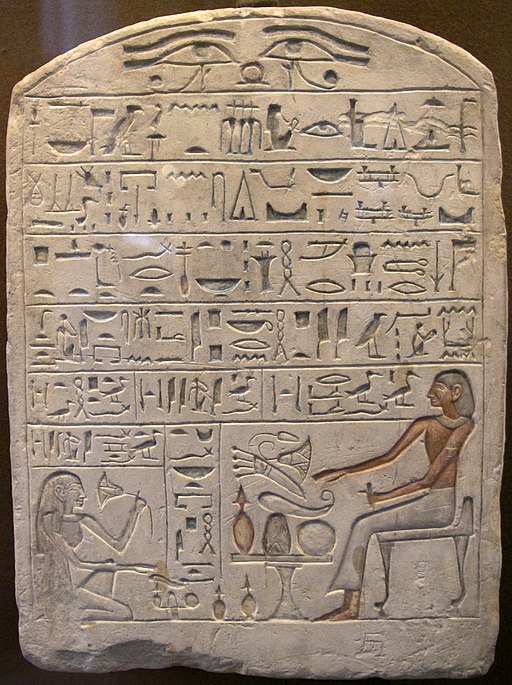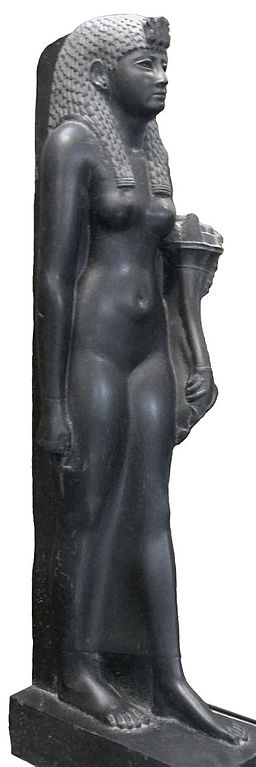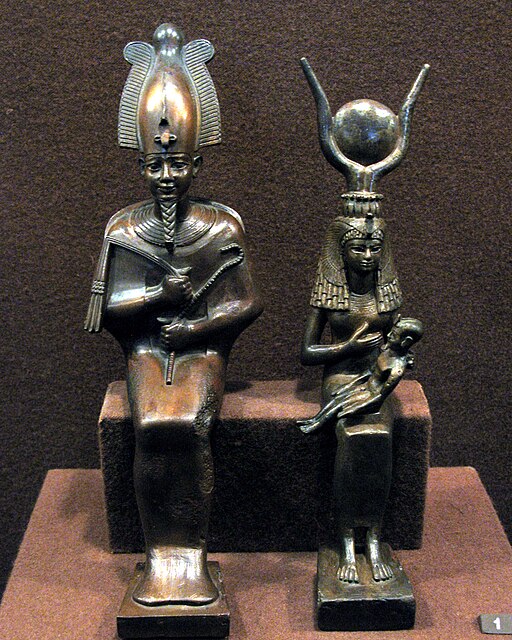
Stela of Pepi, Chief of the Potters
The civilization of ancient Egypt produced ancient Egyptian art in the Nile Valley from about 3000 BC to 30 A.D. Ancient Egyptian art reached a high level of sophistication in painting and sculpture but in a highly stylized and symbolic form.
It was highly conservative, and styles changed remarkably little over more than three thousand years. Much of the surviving art comes from tombs and monuments.
The tomb art was never meant to be seen by people and was produced for the afterlife.
Egyptian Collection in the Hermitage Museum
- Stela of Pepi, Chief of the Potters
- Black basalt statue of Ptolemaic queen Cleopatra VII
- Osiris and of Isis with the baby Horus
- Pyramidion from the tomb of the priest Rer
~~~
Stela of Pepi, Chief of the Potters
This Ancient Egyptian Stele called “Stele of Pepi, Chief of the Potters. Made of limestone during the 18th century B.C. (~12. dynasty). It has six horizontal registers and a smaller vertical register of Egyptian hieroglyphs, which are read right-to-left.
The translation is as follows:
An offering the king gives to Osiris; Foremost of the Westerners; the Great God of Abydos…
Abydos and Wepwawet, Lord of the Sacred Lands, that he may be given a voice offering of bread, beer, oxen, geese, linen, clothes
incense, and oils. The good things the priestess will offer
to the soul of the Overseer of the Potters, Nehy-Ptah-Sokar-en-Pepy, and lady of the house, Timat
and his son, Redidi, the justified. His daughter, Isuri, the justified. His daughter, Hetsa, the justified
His wife, lady of the house; Hepi, the justified
His beloved daughter, Iti, the justified.
An Egyptian stele is a stone generally taller than it is wide, erected as a Grave stele used for funerary or commemorative purposes.
A large number of stelae with inscriptions have survived from ancient Egypt and constitute one of the significant sources of information on Egyptian civilization.
The most famous example of an inscribed stela leading to increased understanding is the Rosetta Stone, which led to the discovery of how to read Egyptian hieroglyphs.
Stela of Pepi, Chief of the Potters
- Title: Stelae of Pepi, Chief of the Potters
- Material: Limestone,
- Date: 18th century B.C. (~12. dynasty)
- Category: Egyptian Art
- Museum: Hermitage Museum
~~~
Black basalt statue of Ptolemaic Queen Cleopatra VII

This Black basalt statue depicts the Ptolemaic Queen Cleopatra VII and was made about 51 – 30 B.C. Cleopatra VII was the last active ruler of the Ptolemaic Kingdom of Egypt.
As a member of the Ptolemaic dynasty, she was a descendant of its founder Ptolemy I Soter, a Macedonian Greek general and companion of Alexander the Great.
After the death of Cleopatra, Egypt became a province of the Roman Empire, marking the end of the Hellenistic period that had lasted since the reign of Alexander (336–323 BC).
Her native language was Koine Greek, and she was the first Ptolemaic ruler to learn the Egyptian language.
Black basalt statue of Ptolemaic Queen Cleopatra VII
- Title: Statue of Ptolemaic queen Cleopatra VII
- Material: Black basalt
- Date: 51 – 30 B.C.
- Category: Egyptian Art
- Museum: Hermitage Museum
~~~
Osiris and of Isis with the baby Horus

These statutes of Osiris and Isis with her baby Horus represent the Osiris myth from ancient Egyptian mythology. It tells the story of the murder of the god Osiris by his brother Set, who usurps his throne.
Meanwhile, Osiris’s wife Isis restores her husband’s body, allowing him to conceive their son, Horus, posthumously. Horus, the son of Isis and Osiris, eventually becomes Set’s rival for the throne.
Their violent conflict ends with Horus’s triumph, which restores Maat, the cosmic and social order to Egypt completes the process of Osiris’s resurrection.
Osiris and of Isis with the baby Horus
- Title: Osiris and of Isis with the baby Horus
- Material: Bronze
- Category: Egyptian Art
- Museum: Hermitage Museum
~~~
Pyramidion from the Tomb of the Priest Rer

This Pyramidion from the tomb of the priest Rer is from the 7th century BCE and comes from Abydos, one of the oldest cities of ancient Egypt.
A pyramidion is the uppermost piece or capstone of an Egyptian pyramid or obelisk. During Egypt’s Old Kingdom, pyramidia were generally made of granite, or limestone, then covered in gold.
A pyramidion was covered in gold leaf to reflect the rays of the sun, and they were often inscribed with royal titles and religious symbols.
Pyramidion from the Tomb of the Priest Rer
- Title: Pyramidion from the tomb of the priest Rer
- Material: Limestone.
- Date: 7th century B.C.
- Category: Egyptian Art
- Museum: Hermitage Museum
The Egyptian Collection in the Hermitage Museum
The extensive Egyptian Collection in the Hermitage Museum also includes the following:
- Egyptian Sarcophagi
- Egyptian Mummy Cases
- Egyptian Mamluk caps
- Egyptian Statues and Statuettes
- Coptic Artifacts
Hermitage Museum
- Name: Hermitage Museum
- City: Saint Petersburg
- Country: Russia
- Type: Art and Culture Museum
- Established: 1754
- Location: 38 Palace Embankment, Dvortsovy Municipal Okrug, Saint Petersburg
Egyptian Collection in the Hermitage Museum
Explore Egyptian Art
- Ancient Egyptian Art and Artifacts – Virtual Tour
- The Rosetta Stone
- The Battlefield Palette 3100 BC
- Quartzite Head of the Egyptian Pharaoh Amenhotep III
- Colossal Granite Statue of Amenhotep III
- Hunters Palette
- Tomb of Nebamun
- Younger Memnon (Ramesses II)
The State Hermitage Museum: A collection of artworks
Explore the Hermitage Museum
- “Madonna Litta” attributed to Leonardo da Vinci
- Composition VI by Kandinsky
- “Portrait of Doña Antonia Zárate” by Francisco Goya
- “White House at Night” by Vincent van Gogh
- “The Three Graces” by Antonio Canova
- Egyptian Collection in the Hermitage Museum
- Gonzaga Cameo
- “Psyche Revived by Cupid’s Kiss” by Antonio Canova
St Petersburg Hermitage Museum
~~~
“An answer if useful in proportion to the intensity of the quest.”
– Egyptian Proverb
~~~
Photo Credit: 1) Andrew Bossi [CC BY-SA 2.0 (creativecommons.org/licenses/by-sa/2.0)], via Wikimedia Commons 2) I, George Shuklin [CC BY-SA 3.0 (creativecommons.org/licenses/by-sa/3.0/)] 3) I, George Shuklin [CC BY-SA 3.0 (creativecommons.org/licenses/by-sa/3.0/)] 4) Hermitage Museum [CC BY-SA 3.0 (creativecommons.org/licenses/by-sa/3.0/)]
Popular this Week








 Sponsor your Favorite Page
Sponsor your Favorite Page SEARCH Search for: Search Follow UsJoin – The JOM Membership Program
Sponsor a Masterpiece with YOUR NAME CHOICE for $5
Share this:
- Tweet
